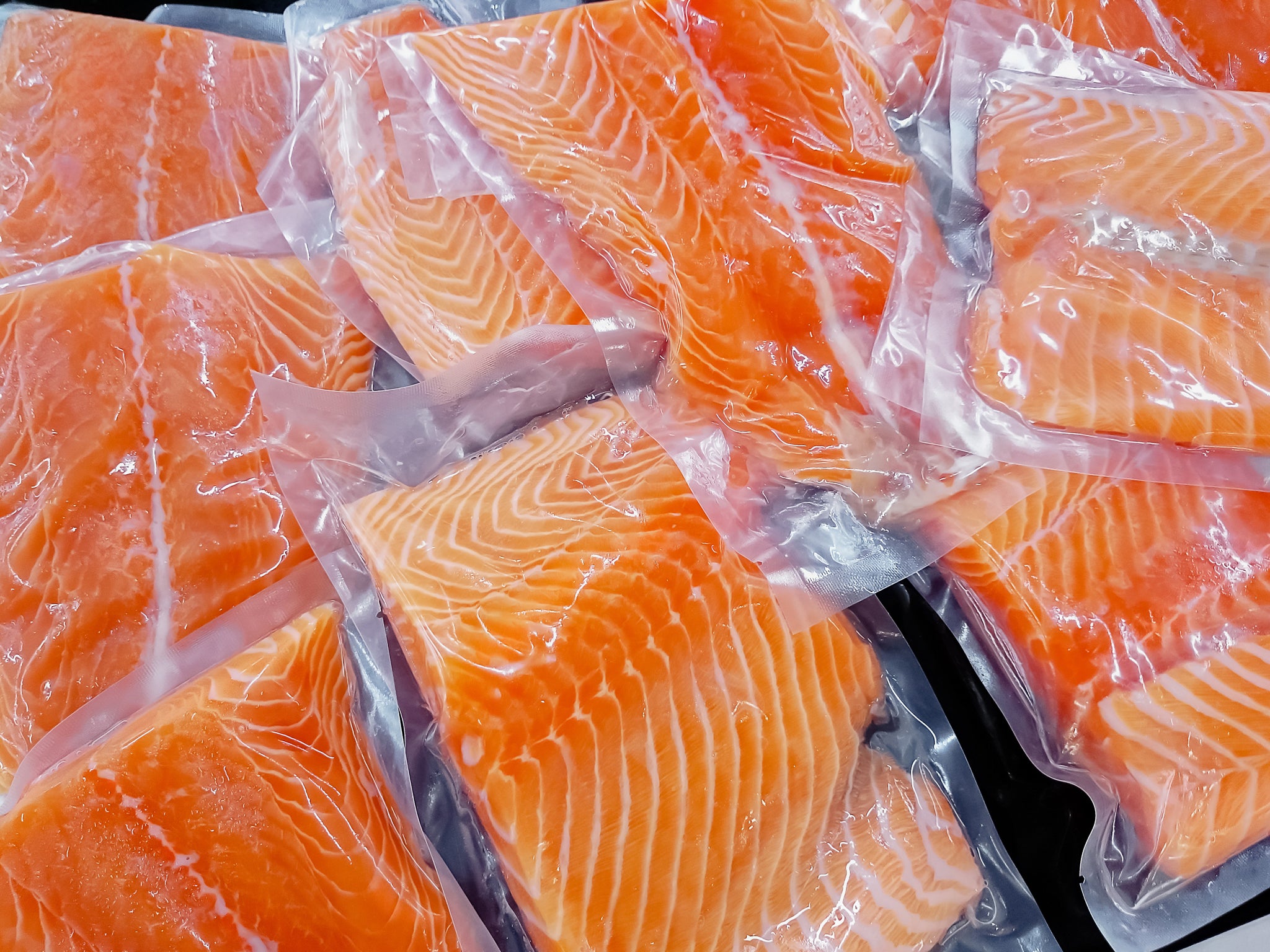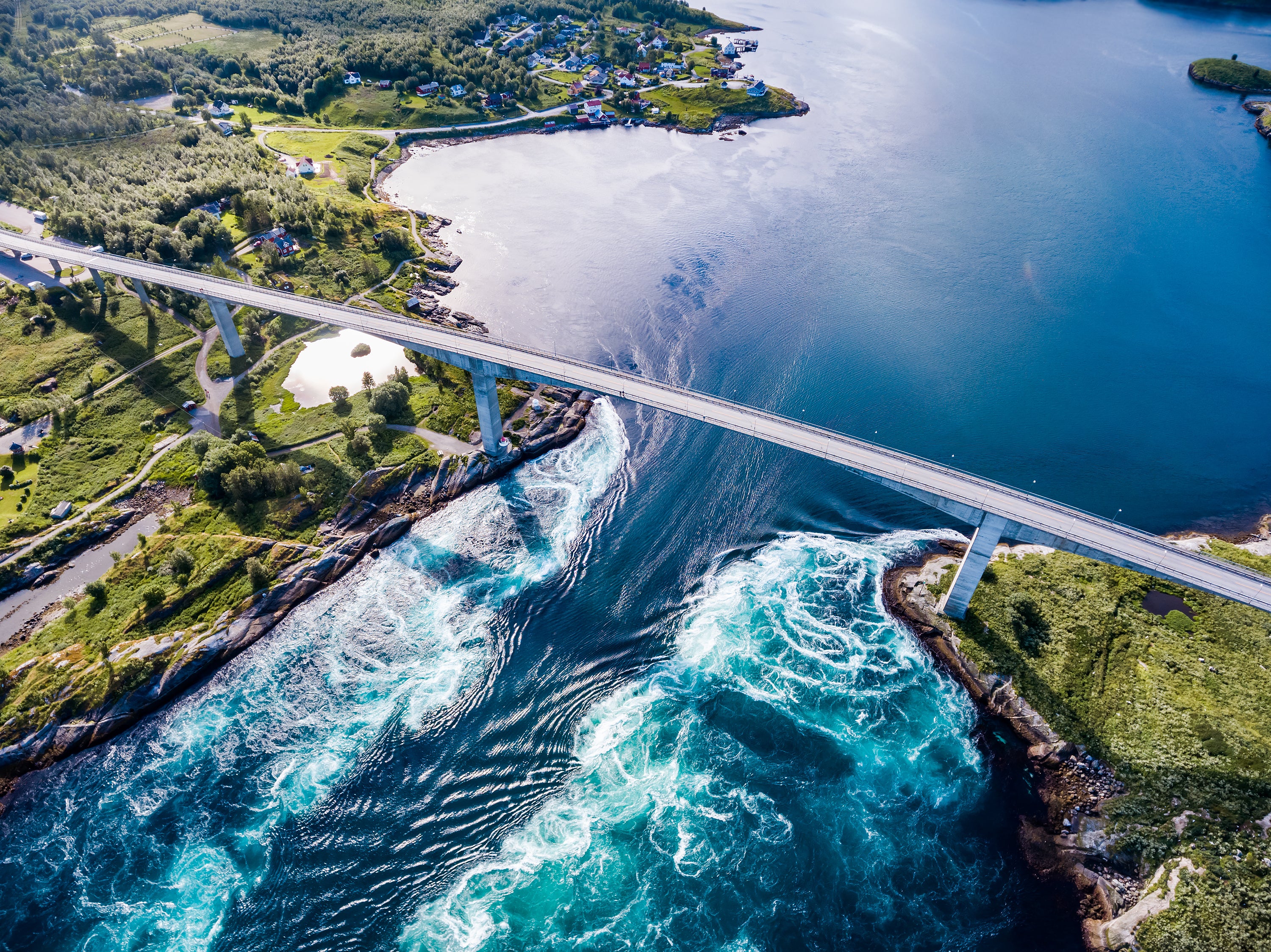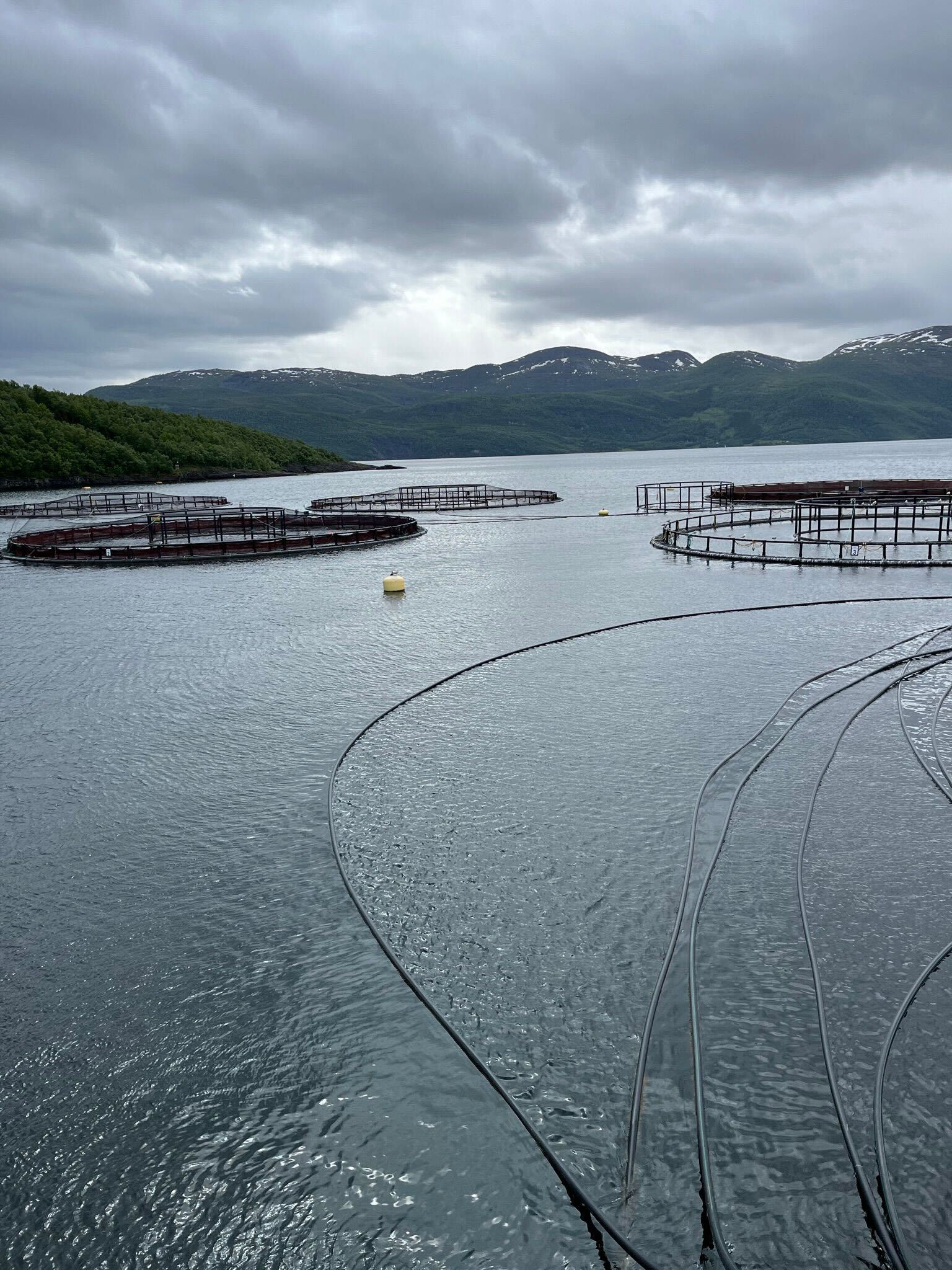Can seafood ever really be sustainable?
Sustainable salmon sounds wonderful but how realistic is it really? In search of the answer, Hannah Twiggs flies beyond the Arctic circle to meet the fish farmers combining underwater lasers with age-old techniques


I’m trying to keep my balance on a floating plastic platform no more than a foot wide, a constant battering of wind, rain and waves ensuring there isn’t a single moment of flat footing, while an enthusiastic Norwegian is reeling off stats about the 20,000 fish swimming in a perpetual circle in the pen we’re teetering on the edge of. Every now and then, below the surface a flash of red streaks across the 20m-wide net. It’s an AI-powered laser shooting sea lice no larger than a centimetre long from the scales of the fish. Yes, you read that correctly.
This is a salmon farm owned by Nordic Blu, a family-run business that has been operating in the Skjerstad Fjord in northern Norway, just above the Arctic circle, since the early 1980s. The fjord looks as picturesque as any other – frighteningly dark water surrounded on all sides by jagged, forested mountains, all bathed in the eerie grey light of the midnight sun – but this one has a hidden talent that makes it uniquely suitable for a sustainable fish farm.
Just around the corner is Saltstraumen, the world’s strongest tidal current, which connects the fjord to the open sea. Through a narrow channel – just 150m-wide – up to 400 million cubic metres of seawater flows every six hours, reaching speeds of 40km/h. Firstly, this phenomenon creates huge whirlpools in the channel, which locals will tell you have wrecked a boat or two. Secondly, and this is the important part, it means the water in the whole fjord is completely recycled within 150 days. Not only does this mean plenty of clean water full of oxygen for the wildlife and farmed salmon in the fjord, but the lice and other parasites that can harm the fish struggle to swim upstream. Any that do are picked off by the aforementioned AI lasers, known as Stingrays.
Nordic Blu has been farming fish in this way, in harmony with the fjord, for over 40 years (obviously, the lasers are a relatively new addition). In the early Eighties, the Wenberg family placed the first homemade pens at the end of the fjord, and with the help of a small rowboat and nearby shack to store the feed, they did everything by hand. On the other side of the fjord, boatbuilderJan Oksheim did the same. Both families watched their little projects closely and carefully, learning from the fjord and their fish. The knowledge was passed down through the generations until, eventually, their children joined forces to form Salten Aqua, and later its sustainable arm Nordic Blu. Fast forward a quarter of a century, and there have clearly been some serious technological advancements.

You could say, then, that the Nordic Blu farms are conveniently, naturally sustainable – location is everything in salmon farming – but that isn’t the whole picture. Fish has long had a marketing problem. Consumers don’t like the word “farmed” in front of their fish (just in front of their beef, pork, lamb and chicken). “Wild” fish sounds a lot sexier, but with the global demand for seafood set to grow at least 40 per cent in the next two decades, and with wild populations of almost every fish species declining due to overfishing, climate change and other environmental pressures, there will be no way to meet the demand without farming it.
Generally, indoor farming is considered to be more sustainable, since there’s no impact on the wider environment, but it scores poorly on other factors such as chemical use. Keeping fish outside, on the other hand, poses other problems, besides the already assassinated sea lice. Without the lasers, chemicals would need to be used to control the parasites, which would impact the other living things in the fjord. When the Stingray’s camera identifies what it thinks is a louse, it zaps it with a surgical diode laser beam, the same used in eye surgery or laser hair removal.
As sci-fi as it sounds, it’s actually just a digitised version of an ancient technique that other farms still use. Instead of lasers, some farms introduce “cleaner fish”, such as wrasse and lumpsuckers, into the pen with the salmon to eat the lice. But this method can’t realistically control big outbreaks, and when the salmon are harvested, the other fish die and go to waste. Nordic Blu’s lasers are so advanced (a bit like the facial recognition software in your phone, they “learn” by doing, becoming more accurate the more they’re put to use), their fish haven’t needed to be medicated since the last outbreak in 2014. This means they can operate completely chemical-free.

So that’s a big box ticked off on the list of problems with the fishing industry: the impact of high-intensity production. Just like any other livestock, if you’re mass-farming fish in the same spot over and over again, the surrounding environment is going to take a hit from any chemicals, antibiotics or pesticides used, not to mention the faeces and surplus food that drops out of the bottom of the nets. Staying true to their decades-old philosophy of working with nature, Nordic Blu constantly monitors the health of the fjord – they’re obligated by law to do this once a year, but they carry out the checks far more frequently. “If we destroy this, then it’s all over,” the Norwegian tells me.
A man in a corporate building at their HQ several miles away sits in front of a wall of screens filled with live footage of the nets and constantly moving graphs. These tell him various things about the fjord and the fish, including their estimated weight, which he uses to ensure no feed is wasted. Said feed is also completely organic, which not only keeps the salmon healthy and resistant to disease, but doesn’t impact the fjord. The nets are moved around between harvests, essentially creating a “fallow” area that is left to recover. While the salmon has a relatively low climate footprint, Nordic Blu also makes efforts to reduce any greenhouse gas emissions across the whole system, from fuel for the boats and the electricity that runs the facilities, to the footprint of anything they ship in, such as the feed.
One of the most obvious problems with farming in open net pens is escapes – it’s very much an underwater Jurassic Park situation in which a highly carnivorous dinosaur (in this case a salmon) bred entirely in captivity breaks through and hunts down and eats every living thing (in this case other wild fish and marine organisms and probably not any humans) in sight. While not ideal for Nordic Blu, an escape is actually a great money-making opportunity for local fishers – desperate to minimise the damage to the environment (and in turn their reputations) fisheries put out a hefty bounty on escapees. Unfortunately, there haven’t been any “major” escapes in the past decade thanks to underwater cameras and regular dives to maintain the nets, so I’ll have to park that side hustle for now.
Right now, it’s a luxury product. It’s a communication problem ... As people become more conscious of sustainable seafood, we will move towards a place where there is more sustainable seafood. When the consumers demand it, the restaurateurs are the first ones to move
All of that is no doubt a massive oversimplification and not an exhaustive list of their sustainability efforts, but it has led Nordic Blu to receive various globally recognised certifications. Indeed, it wasn’t until Salten Aqua was approved by the Monterey Bay Seafood Watch Programme, a US-based but globally recognised ranking on sustainability in seafood, in 2018 that Nordic Blu, the uber-sustainability-focused arm, even came to life. Additionally, their Atlantic salmon didn’t just get the first green rating in the world, it also got the highest green rating you can possibly get, which certainly ruffled a few scales in the US. They were also one of the first in the world to be recognised as both organic and ASC-certified at the same time (the ASC label only appears on produce from farms that have been assessed as being environmentally and socially responsible).
If I have come here to ask whether seafood can ever truly be sustainable, the answer is undoubtedly: yes, it can, but with one catch (pun intended). When you pick up a packet of salmon in a supermarket, no matter where you are in the world, and see some kind of sustainability sticker on it, this certification only applies at source. This means that the production of that salmon was considered to be sustainable at the time a regulator visited the facility. That sticker does not apply to the environmental impact of exporting it around the world.
If you’re picking up that packet of Nordic Blu salmon in, for example, the US, their biggest buyer, it has had to travel 4,463 miles at the very least to get there. The packet won’t tell you what mode of transport was used, but given that most fish is frozen at source and therefore not considered “highly perishable”, it can be safely assumed that it arrived by boat. (You probably didn’t know that almost all fish in the supermarket has been frozen at source, and then defrosted before it’s put on the “fresh” shelf. Therefore, the frozen fish is likely to be fresher.)
While, yes, boat travel produces significantly fewer carbon emissions, frozen fish has to be kept at -18C for the entirety of the trip and thereafter, so you have to factor in the cost – financial and environmental – of keeping the freezers running. That’s before you even consider the emissions produced by the lorries that transport the goods on either end, or, indeed, the pollution the boat pumps straight back into the very water the sustainable fish came out of. If it’s someone’s job out there to calculate all this stuff, I don’t envy you.
But it does pose an important question when we’re talking about sustainable product: is it all worth it if all your hard work is undone the minute that product is loaded onto a plane? Someone who certainly thinks so is Pepijn (Pep, for short) de Visscher, who runs The Seafood Bar restaurant franchise with his sister Fleur and father Fons, who founded the company. Like Nordic Blu, The Seafood Bar has humble, family-oriented roots. After working as a fishmonger in a small city in the Netherlands for 30 years, Fons opened the first site in Amsterdam in 2012, bringing his children on to help him soon after. Well, he didn’t necessarily mean to open a restaurant. He thought it would be a neat idea to put some tables and chairs in his shop, but when people flocked in and sat down, he realised: “I guess now I have to take orders!”
It became hugely popular, and in just 10 years, they opened four more sites – two more in Amsterdam, one in Utrecht and most recently one in London on Dean Street – with Fleur and Pep slowly taking over from their father, who is “ready for the quiet life”, he tells me. Sustainability has always been at the forefront of their restaurants. Their approach is manifold: as well as choosing the best available fish from sustainable and innovative fisheries like Nordic Blu, there’s also a strong menu focus on shellfish, which is known for having a minimal impact on the planet. They’ve installed water purification machines at their Dutch sites to avoid the CO2 cost of transporting bottled water in. All of their restaurants run on wind energy; their site in Utrecht goes one step further by using zero gas. Almost all plastic packaging has been replaced with paper, and they operate a zero waste policy: if there’s an excess of seafood at one restaurant, they’ll exchange it with another, rather than letting it go to waste.
That’s quite a manifesto. Pep believes restaurants need to pick up the sustainable salmon story where Nordic Blu left it. “Right now, it’s a luxury product. It’s a communication problem,” he tells me, during oyster happy hour at the Spui 15 site in Amsterdam. He describes it much like a chicken or the egg situation. “As people become more conscious of sustainable seafood, we will move towards a place where there is more sustainable seafood. When the consumers demand it, the restaurateurs are the first ones to move, and then the suppliers. It’s a chain and everyone needs to become more conscious. But it starts with the consumers.”
So it’s on us then to demand the change we want to see. If you sit down at a Seafood Bar and pick up a menu, you’ll see a note at the bottom about Nordic Blu: “The world’s most sustainably farmed salmon”. The Seafood Bar goes to great lengths to educate their diners about the origins of the seafood they’re eating at the restaurant – which The Seafood Bar has not only paid more for than standard salmon, but also higher than market rate to cement Nordic Blu as their supplier. “If customers aren’t coming to the restaurant for the sustainable seafood, for Nordic Blu, then what’s the point? Everyone’s basically just losing money. It’s really important where we tell the story. We need to make people conscious of the fact that it exists” at the restaurant level. He adds that the media has a part to play in this, too. When was the last time you saw an advert, on TV or in a newspaper, for sustainable seafood? Compare that to every “organic”, “free range” or “regeneratively farmed” you see in front of eggs, beef, pork, chicken and lamb.
It’s something they’re already doing in the meat industry – and they’re doing it well. So if you’re prepared to go to a particular restaurant for Kobe or Philip Warren beef, to name a few, why not go for Nordic Blu salmon too? Let’s get that chain moving.
Join our commenting forum
Join thought-provoking conversations, follow other Independent readers and see their replies
Comments





Bookmark popover
Removed from bookmarks